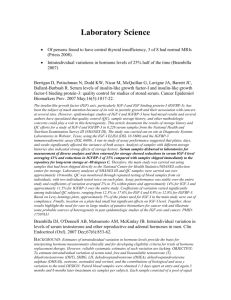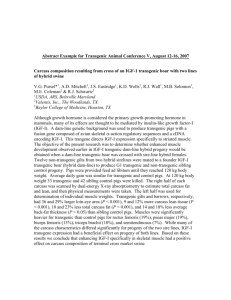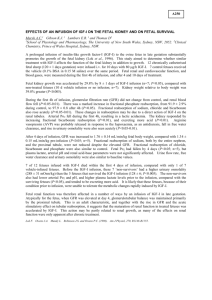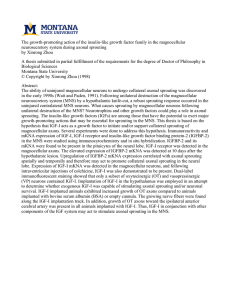Example_Lab_Report
advertisement
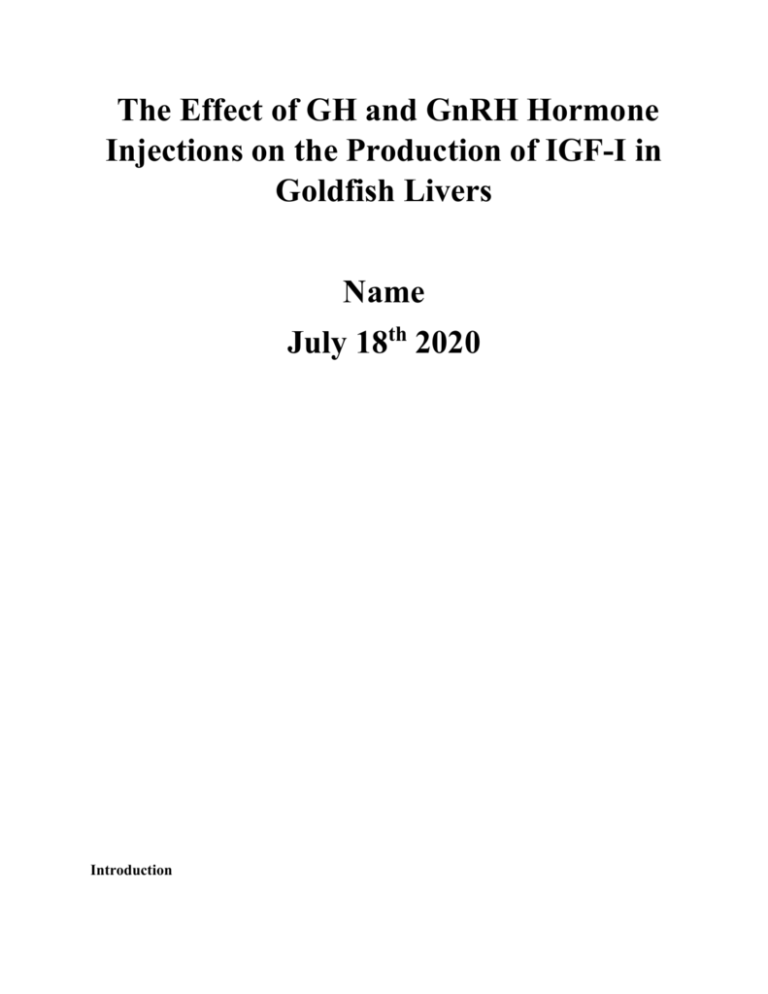
The Effect of GH and GnRH Hormone Injections on the Production of IGF-I in Goldfish Livers Name July 18th 2020 Introduction In vertebrates, growth is a multifactorial characteristic resulting from a very complex genetic and molecular interactions in which hormones are the major factors. The growth regulator GH also carries out other physiological process such as having an effect on lipids, protein and carbohydrate metabolism. (Davidson 1987; Moller and Norrelund, 2003) immune system maintenance, Jeay et al., 2003) and response behavior to stress (Yoshizato et al.,1998). GH biological processes are carried are control solely at the somatotrophs in the anterior part of the pituitary gland and on all of the target organs that interact with certain cell surface receptors called the GHR. Both the GHR and GH depends on both the environment and biological factors. (Flores-Morales et al, 2006). Insulin-like growth factors (IGFS) are polypeptides that are primarily produced in the livers and are important regulators of growth and differentiation. The nucleotide and amino acids sequences IGF-I have been determine in a number of mammalian and nonmammalian species. In mammals, growth hormones (GH) stimulates the production of IGF-1. (Kermouni et al., 1998). Similar GH stimulatory effects of IGF-I have been reported in several fish species.IGF-I has been isolated from goldfish liver and ovary with five IGF-I isoforms identified. PCR, a DNA amplification technique, may be used to quantify the levels of multiple samples of DNA PCR acts by replicating multiple copies of DNA sample using the appropriate primer and a pool of nucleotides.( (Kermouni et al.,1998). IGF-I is mainly produced in liver which is the main source of circulating( endocrine) IGF-I under the influence of growth hormone( GH). IGF-I released from the liver into the circulation acts on a variety of target cells. Also IGF-I also expressed, in extrahepatic sites and most likely stimulates organ –specific functions by paracrine and autocrine processes. There is increasing evidence that GH stimulates the expression of IGF-I also in extrahepatic sites. (Vong et al., 2003, Biga et al., 2004). In this virtual lab, the researcher hypothesized that the goldfish that received either GH or GnHR injections will result in elevated levels of IGF-I production in the goldfish liver. Methods Goldfish specimens were obtain. Carassius auratus, that range in size from fout to five grams. Maintain the fish in flow-through aquaria and feed them commercial fish food. Then two experiments were set up, one testing the effects of GH on IGF-I production and a second testing the effects of GnRH on IGF-l production. (Kermouni et al.,1998) In the first experiment, the experiment group of fish was set up and the fish received two intraperitoneal injection (12 hours apart) of 2micrograms/g of carp GH. After that the control group of fish received no hormone treatment. (Kermouni et al.,1998) In the second experiment, the experiment group of fish was set up and the fish received two intraperitoneal injections (12 hours apart) of 2micrograms/g of salmon GnRH. After that the control group of fish received no hormone treatment. (Kermouni et al.,1998) After the application of treatments was applied, the fish were sacrificed and all of their livers were removed. Then RNA was extracted from the liver. After that cDNA for goldfish IGF- mRNA using primers of carp IGF-I sequences. After synthesizing cDNA was synthesized from the goldfish IGF-l, then a Competitive Quantitative-PCR system called Q- PCR was set up. This system involved preparing two separate DNA samples with the same 3’ and 5’ ends so that the samples compete for the same PCR primers and will result in a higher PCR product. (Kermouni et al.,1998) Specifically in these experiments, an internal standard template was set up using a 700-bp fragment coding for a plant protein, oleosin. After that, a synthetic oligonucleotide was ligated for a specific goldfish IGF-l to the 3’ and 5’ ends of the oleosin cDNA. The chimeric oleosin cDNA was then placed into PCR reaction tubes with the 500-bp goldfish IGF-I cDNA and specific IGF-I primers. The concentration of oleosin was adjusted and the standard template was added to the PCR tubes from 0.1 to 1 pg/tube in the GH treatment and 0.0001 to 0.04 ng/tube in the GnRH treatment. Because both the oleosin template and the goldfish IGF-I cDNAs, have identical 3’ and 5’ ends they complete for the same primers. The PCR products were separated using gel electrophoresis. Two PCR results, a 500-bp DNA band, corresponding to the IGF-I cDNA and a DNA band, corresponding to the oleosin template cDNA. (Kermouni et al.,1998). After that gels images were scanned and the band densities were measured. The relative quantities of IGF-I and oleosin template c DNA were determine, then the ratio of oleosin internal standard/ IGF-I was calculated for each concentration of oleosin standard that was added to the PCR system. Then the ratio was plotted this against the concentration of the oleosin standard. The effect of hormone treatment was determined by comparing the experimental ratios to the control ratios. Then the results of the GH experiment were recorded. (Kermouni et al.,1998). Results According to the experimental results in the virtual lab, table 1 shows the effect of GH hormone on IGF-I production in goldfish liver at which the oleosin template added to the PCR on the ratio of oleosin template on the production of IGF-I c DNA. It also shows the mean of the control and the GH treatment on IGF-I production. Figure 1 shows GH injections on IGF-1 production in goldfish livers. Table 2 shows the effect of Gnarr hormone on IGF-I production in goldfish liver at which the oleosin template added to the PCR on the ratio of oleosin template on the production IGF-I c DNA. It also shows the mean value for the control and Gnarr treatment on IGF-I production. Figure 2 shows Gnarr injections on IGF-I production in goldfish livers. A statistical analysis two tailed t-test was performed on GH and Gnarr injections on IGF-I production in goldfish livers. The mean values for the GH treatment in group 1 was 0.425 and group two was 2.3. The mean for the control in group 1 was 0.45 and in group 2 it was 8.45. The p values were .360 for GH treatment and 0.308 for the control. The t values were 0.99 for GH treatment and 1.11 for the control. The degree of freedom was 6 for both the GH treatment and the control. The standard deviation for the GH treatment and the control was the same at .40311 in group 1, but in group 2 it was 14.2 for the control and 3.8 for the GH treatment. The p values were 1.01 for the control and .056 for Gnarr treatment. The t values for the control was 1.8 and for the Gnarr it was 2.16. The degree of freedom was the same for both at 10. The means for group 1 were the same at 0.009 for both the control and the Gnarr treatment. The mean for group 2 was 8.34 for the control and Gnarr was 1.06. The standard deviation were the same for group 1 control and Gnarr at 0.01545 and group 2 it was 11.2 and 1.19 respectively. The degree of freedom was the same at 10. Table 1 The Effect of GH Hormone on IGF-I Production in Goldfish Liver GH Injections in Goldfish Causing Increase Production of IGF-I Oleosin template added to PCR(pg) Ratio of Oleosin template/IGF-I cDNA 0.1 0.2 0.4 1 Mean 0.425 s.d 0.403 Control 0.3 0.5 3 30 Mean 8.45 P=0.308 t=1.11 s.d 14.1 d.f=6.0 GH Treatment 0.09 0.2 1 8 Mean 2.3 P=.360 t=0.99 s.d= 3.81 d.f=6.0 Figure 1 GH Injections on IGF-I in Production in Goldfish Livers Ratio of oleosin template/IGF-I cDNA 100 10 GH Treatment Control 1 0.1 0.1 0.2 0.4 1 Oleosin template added to PCR (pg) Table 2 The Effect of GnHR Hormone on IGF-I Production in Goldfish Liver GnHR Injections in Goldfish Causing Increase Production of IGF-I Oleosin template added to PCR(pg) Ratio of Oleosin template/IGF-I cDNA 0.0001 0.0004 0.001 0.005 0.01 0.04 Mean 0.09 s.d .015 Control 0.04 1 2 7 10 30 Mean 8.34 P=1.01 t= 1.81 d.f =10 s.d=11.3 GnHR Treatment 0.3 0.04 0.2 0.8 2 3 Mean 1.06 P=.056 t=2.16 d.f.=10 s.d.=1.19 Figure 2 GnHR Injections on IGF-I Production in Goldfish Livers Ratio of oleosin template/IGF-I cDNA 100 10 Control 1 GnHR Treatment 0.1 0.01 0.0001 0.0004 0.001 0.005 0.01 0.04 Oleosin template added to PCR (ng) Discussion In conclusion, growth in vertebrates is controlled by many factors, such as genetics and environmental factors (Moriyama et al., 2000) The hypothalamus in mammals produces two antagonistic hormones, growth hormone –releasing hormone (GHRH) and somatostatin (SS) which act to control the growth hormone (GH) release from the pituitary glands through the process of stimulation or inhibition of its secretion, respectively (Arvat et al., 2002). This process is more complicated in fish, because the regulation of growth hormones basically happens through the use of GHRH and SS a well as though other hormones, which includes dopamine, GnRH, thyrotropin-releasing hormones (TRH), and pituitary adenylate cyclase- activating polypeptide ( PACAP) (Riley et al., 2002) The higher the ratio of oleosin template/ IGF-I the greater the levels of oleosin template compared to IGF-1. If there were no effect of GH treatment, the ratios for the control and GH treatment groups would be the same. There was a positive correlation between the concentration level of the oleosin template added to PCR and the ratio of oleosin template/ IGF-I c DNA. (Kermouni et al.,1998). The GnRH treatment resulted in decreases in the ratios of oleosin template IGF-I, indicating an increase in IGF-I production in fish treated with GnRH. There was a positive correlation between the concentration level of the oleosin template added to PCR and the ratio of oleosin template/ IGF-I c DNA. (Kermouni et al.,1998). In this virtual lab, the hypothesis was supported and accepted by this data which showed both p values at < 5. Literature Cited Arvat, E., Broglio, F., Aimaretti, G., Benso, A., Giordano, R., Deghenghi, R., & Ghigo, E. (2002). Ghrelin and synthetic GH secretagogues. Best Practice & Research Clinical Endocrinology & Metabolism, 16(3), 505-517. Biga, P. R., Schelling, G. T., Hardy, R. W., Cain, K. D., Overturf, K., & Ott, T. L. (2004). The effects of recombinant bovine somatotropin (rbST) on tissue IGF-I, IGF-I receptor, and GH mRNA levels in rainbow trout, Oncorhynchus mykiss. General and comparative endocrinology, 135(3), 324-333. Davidson, M.B., 1987. Effect of growth hormone on carbohydrate and lipid metabolism. Endocr. Rev. 8, 115–131. Flores-Morales, A., Greenhalgh, C.J., Norstedt, G., Rico-Bautista, E., 2006. Negative regulation of growth hormone receptor signaling. Mol. Endocrinol. 20, 241–253. Jeay, S., Sonenshein, G.E., Postel-Vinay, M.C., Kelly, P.A., Baixeras, E., 2002. Growth hormone can act as a cytokine controlling survival and proliferation of immune cells: new insights into signalling pathways. Mol. Cell. Endocrinol. 188, 1–7. Kermouni, A., Mahmoud, S. S., Wang, S., Moloney, M., & Habibi, H. R. (1998). Cloning of a full-length insulin-like growth factor-I complementary DNA in the goldfish liver and ovary and development of a quantitative PCR method for its measurement. General and comparative endocrinology, 111(1), 51-60. Moriyama, S., Ayson, F. G., & Kawauchi, H. (2000). Growth regulation by insulin-like growth factor-I in fish. Bioscience, biotechnology, and biochemistry,64(8), 1553-1562. Moller, N., Norrelund, H., 2003. The role of growth hormone in the regulation of protein metabolism with particular reference to conditions of fasting. Horm. Res. 59 (Suppl. 1), 62–68. Riley, L. G., Hirano, T., & Grau, E. G. (2002). Rat ghrelin stimulates growth hormone and prolactin release in the tilapia, Oreochromis mossambicus.Zoological science, 19(7), 797-800. Vong, Q. P., Chan, K. M., & Cheng, C. H. (2003). Quantification of common carp (Cyprinus carpio) IGF-I and IGF-II mRNA by real-time PCR: differential regulation of expression by GH. Journal of Endocrinology, 178(3), 513-521. Yoshizato, H., Fujikawa, T., Soya, H., Tanaka, M., Nakashima, K., 1998. The growth hormone (GH) gene is expressed in the lateral hypothalamus: enhancement by GH-releasing hormone and repression by restraint stress. Endocrinology 139, 2545–2551.
